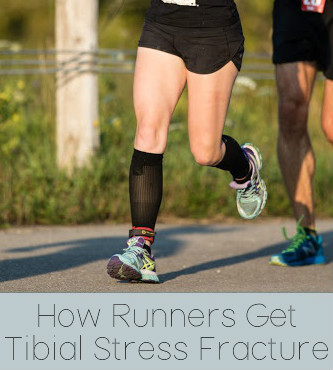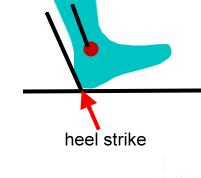At faster running speeds during heel strike running, impact transients increase and are poorly absorbed by the heel pad, even in a cushioned heeled running shoe. As a consequence, a heel strike runner becomes more vulnerable to a shin fracture.
Here are the 2 main factors that cause stress fractures of the tibia in runners who heel strike.
2 Causes of Stress Fractures of the Tibia in Heel Strike Runners
High Acceleration and Loading
To quantify ground reaction forces in heel strike running, researchers measure tibial peak acceleration and loading rates.
- heel strikers generate high tibial peak acceleration and high loading rates which are major risk factors for stress fractures
Heel Pad Breaks-Down
The human heel pad contains a venous plexus which acts as a shock absorber. The venous plexus effectively absorbs impact at walking speeds, but quickly deforms when running on the heels.
One investigation found that the venous plexus failed to dampen the ground reaction force in heel strike runners:
- impact forces penetrated through the heel pad, up the skeleton
- the heel pad lost most shock absorption properties during running, but not during walking
The scientists concluded that the shock absorbing properties of the heel pad works best when walking, but not for heel strike running.
Other work has found that the human heel pad operates close to its pain threshold at fast walking speeds while barefoot, which is why when running, barefoot runners prefer a forefoot strike.
Many researchers believe that forefoot running is encouraging to use as a preventive strategy for lower leg stress fractures because it eliminates the peak ground reaction at touchdown.
More Good Stuff at Run Forefoot:
Heel Strike – What causes a runner to land on the heels.
Runners Knee – Heel strikers are more prone to knee pain than forefoot strikers.
Lower Back Pain – The forces of heel strike running may alter lower back position.
Avoid Heel Strike – Tips on how NOT to heel strike while running.
References:
Crowell, HP and Davis, SI. (2011). Gait retraining to reduce lower extremity in loading in runners. Clin Biomech, 2011; 26(1):78-83
Friesenbichler, B. (2011). Tissue vibration in prolong running. J Biomech, 2011; 44(1):116-20.
Wiejers, RE. (2005). The dampening properties of the venus plexus of the heel region of the foot simulated at heel strike. J Biomech, 2005;38(12):2423-30.
Bretta Riches
BSc Neurobiology; MSc Biomechanics candidate, ultra minimalist runner & founder of RunForefoot. I was a heel striker, always injured. I was inspired by the great Tirunesh Dibaba to try forefoot running. Now, I'm injury free. This is why I launched Run Forefoot, to advocate the health & performance benefits of forefoot running and to raise awareness on the dangers of heel striking, because the world needs to know.
Latest posts by Bretta Riches (see all)
- Can You Run In Barefoot Shoes? Yes, But DON’T Heel Strike! - 21/07/2024
- Why Cushioned Running Shoes Are Really Bad for Your Feet - 19/07/2024
- Do Cushioned Running Shoes Cause Injuries? - 17/07/2024



Leave a Reply